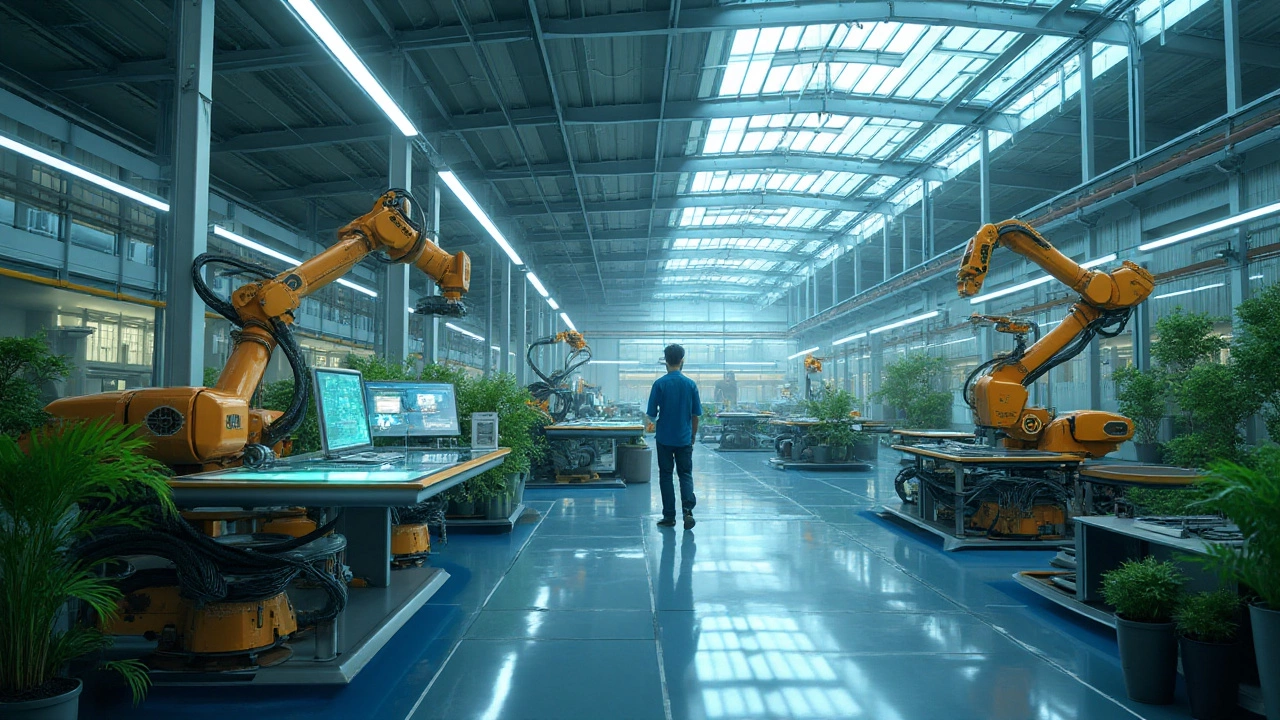In today's competitive landscape, launching a manufacturing startup is both exciting and challenging. To unlock the doors to success, one should dive deep into understanding the intricacies of the industry. Whether it's crafting bespoke furniture or developing tech-savvy gadgets, the journey begins with a unique idea that caters to market needs.
Armed with a robust business plan, budding entrepreneurs can navigate the complexities of product development, material sourcing, and setting up operations. Emphasizing innovation, sustainability, and efficient use of resources can set a business apart. Moreover, leveraging modern-day technologies not only streamlines processes but also offers a competitive edge.
Embarking on this path requires passion, persistence, and a keen sense for detail. By harnessing these elements, along with practical strategies, anyone can transform their dream into a thriving manufacturing business.
- Identifying Opportunities in the Manufacturing Sector
- Building a Strong Business Plan
- Navigating the Production Process
- Utilizing Technology and Sustainable Practices
Identifying Opportunities in the Manufacturing Sector
When embarking on a journey to start a manufacturing startup, the first and perhaps most critical step is to identify the right opportunities within the sector. This involves a deep dive into understanding the current market trends, consumer demands, and production challenges. With the world economy changing rapidly, driven by technological innovation and shifts in consumer behavior, opportunities are abundant but require a keen eye to recognize. For instance, the demand for sustainable products and eco-friendly manufacturing processes has surged over the past decade. Entrepreneurs who align their business models with these trends are more likely to meet the consumers’ growing preference for green products. Diving into sector-specific statistics can provide insight into high-growth areas—industries like electronics, renewable energy components, or even recycled materials can often offer unexpected potential.
Understanding the local and global competition is another crucial element. Aspiring entrepreneurs should analyze what existing companies are doing and where they might be lacking. This can highlight gaps in the market that fresh businesses could exploit. For example, local manufacturers might focus on mass production, leaving room for niche, personalized product production that a small business from scratch could master. Furthermore, technological advancements have opened doors for small businesses to leverage innovations such as 3D printing, CNC machines, and automation to produce high-quality goods at lower costs. Being aware of these advances allows entrepreneurs to tailor their offerings uniquely and competitively.
Networking with industry professionals and attending trade shows can also unveil hidden opportunities. Engaging with experts provides insights into emerging market needs and potential collaborators or mentors who can provide guidance along the way. From industry blogs, it’s evident that there are significant supply chain challenges today. Solutions that simplify logistics, reduce costs, or enhance efficiency are highly sought after.
According to the World Economic Forum, “Manufacturing accounts for approximately 16% of global GDP, and the pandemic has catalyzed efforts to create more resilient supply chains.”This highlights a growing appetite for solutions that boost resilience and flexibility in production and logistics.
Moreover, regulatory changes often bring fresh opportunities. Governments worldwide are offering incentives for energy-efficient products and sustainable practices, which manufacturing startups can capitalize on. Entrepreneurs should regularly review policy changes that could impact their ventures either positively, such as tax breaks, or negatively, like increased tariffs. Additionally, consumer-based research, including surveys and focus groups, plays a vital role in identifying what potential customers desire but can’t currently find in the market. The insights gathered here are invaluable for shaping production ideas and marketing strategies.
In the digital age, even global trends such as digital transformation and artificial intelligence are reshaping the manufacturing landscape. Businesses are increasingly looking to incorporate smart technology for better precision, reduced waste, and higher profitability. Therefore, startups that can innovate in these areas will be poised for success. Engaging with tech companies for potential partnerships could create synergies that benefit both parties. Combining creativity with a thorough understanding of market dynamics enables new manufacturers to carve out profitable niches while offering something genuinely valuable. By keeping abreast of technological and mindsets shifts within the industry, remaining flexible to capitalize on emerging opportunities becomes not just a strategy but a necessity.

Building a Strong Business Plan
Creating a rock-solid business plan is the cornerstone of your manufacturing startup’s success. This document isn’t just a roadmap; it's a comprehensive blueprint that outlines your company’s path and purpose. It begins with a compelling executive summary that captures the essence of your business concept. Here, clarity is power. Articulate both your short-term and long-term goals. Describe the manufacturing startup idea with precision. Whether it's a new technology gadget or a sustainable packaging solution, make it resonate with potential investors and partners.
One significant part of a strong business plan is market analysis. This involves a deep dive into the industry landscape, identifying your target customers, and analyzing your competitors. Knowing who you’re up against and understanding customer demands can give you a strategic advantage. Use tools like SWOT analysis to gauge your strengths, weaknesses, opportunities, and threats. Integrating real-world data and statistics about market growth can lend credibility and conviction to your narrative. According to a study by Statista, the global manufacturing market is set to reach $44.5 trillion by 2030, illustrating the vast opportunities awaiting innovative minds.
Financial projections are another critical component that should not be overlooked. Investors are keen to see well-rounded projected income statements, cash flows, and balance sheets. Detail your initial funding requirements and outline how you plan to utilize these funds effectively. Be realistic but optimistic in your forecasts. If bootstrapping, clarify your funding sources, whether it's personal investment, family contributions, or angel investors. When Steve Jobs started Apple in his garage, his vision and precise financial management laid the groundwork for a tech empire.
Don’t forget the operational plan, which covers production logistics, supply chain dynamics, and key milestones. Discuss the process of material sourcing, and whether you plan to manufacture in-house or outsource production. Emphasizing these elements shows readiness and reliability, crucial traits for any entrepreneur venturing into the business from scratch. Involving agile and lean methodologies in your operations can improve efficiency and help manage resources judiciously.
A strong business plan also emphasizes the marketing and sales strategy. How will you position your product in the marketplace? This encompasses your branding, pricing strategy, and distribution channels. A well-outlined plan should cater to the increasing demand for eco-friendly and socially responsible products. According to a Nielsen report, 73% of consumers are willing to change their consumption habits to reduce environmental impact, a trend that manufacturing startups should be quick to leverage.
Lastly, consider including a strategic partnership section. Collaboration with seasoned players in the industry can provide invaluable insights and open doors to resources that are otherwise inaccessible. Reflect on potential alliances, be it supply chain experts, technology platforms, or even academic institutions for research and development. Remember, partnerships can accelerate growth and bring richness to your business journey.

Navigating the Production Process
Starting a manufacturing startup involves understanding and mastering the production process. Your journey begins with meticulous planning and foresight. First, identify your production goals by analyzing what you want to deliver to the market and the unique features that set your product apart. Once your objectives are clear, it's time to develop a step-by-step strategy that lays out every stage of manufacturing. This could range from procuring raw materials to quality control and final packaging. Each step plays a crucial role in determining the product's success, so it’s essential to approach them with precision and dedication.
Now, let us delve into product design and development. This phase requires creativity, technical knowledge, and a deep understanding of consumer needs. Work with designers and engineers to sketch prototypes and test them rigorously to ensure functionality and durability. Many successful entrepreneurs have emphasized testing as an iterative process where feedback shapes the final design. For instance, a prototype might look perfect on paper, but real-world application could reveal potential flaws. Continuous improvement and adaptation are key to perfecting your product.
In manufacturing, time is money, quite literally. It is vital to streamline your production process for efficiency. Employing techniques like Lean Manufacturing can help reduce waste and improve throughput. This methodology focuses on value-added activities, cutting down unnecessary steps that consume time and resources. To illustrate, Toyota, a pioneer in Lean Manufacturing, has underscored its effectiveness. A quote from Taiichi Ohno, a major contributor to Toyota's production system, serves to emphasize this:
“All we are doing is looking at the timeline; from the moment the customer gives us an order to the point we collect the cash. And we are reducing that timeline by removing the non-value-added wastes.”By integrating such practices, businesses can achieve higher efficiency and product quality.
A key aspect of the production process is ensuring a reliable supply chain. Your choice of suppliers can make or break your operation. It’s crucial to build strong, trustworthy relationships with vendors who provide quality materials on time. Negotiate favorable terms, but also maintain a fair partnership. Disruptions in supply can lead to halts in production, so including contingency plans and backup suppliers is wise. This foresight helps mitigate risks that could otherwise derail production schedules and result in financial loss. Regular evaluations and communications with suppliers ensure transparency and reliability, setting the foundation for a smoother manufacturing experience.
Technology plays a transformative role in modern manufacturing. From automation to advanced ERP systems, understanding these tools can greatly enhance productivity. Implement machines or software that align with your business goals and workflow. For instance, integrating IoT devices allows for real-time monitoring and data analytics, offering insights that drive process improvements. This can be particularly beneficial for startups, as accurate data aids in making informed decisions and quickly adapting to changing demands. Investing in technology up front can streamline operations and potentially reduce costs in the long run.
Finally, the journey doesn't end with production. Quality control is a crucial step that ensures your product meets required standards and delights customers. Implement comprehensive testing methodologies to catch defects early. Decisions during this phase have lasting impacts on your brand's reputation and customer satisfaction. Additionally, customer feedback post-sale offers valuable insights for continuous improvement. By investing in quality control measures, you're investing in your startup's longevity.

Utilizing Technology and Sustainable Practices
Integrating technology into your manufacturing startup not only streamlines your operations but also positions your business for growth in the modern marketplace. Automation, for example, can boost efficiency significantly by minimizing human error and reducing operational costs. It's fascinating how robotics can take over repetitive tasks, freeing up human resources for more complex roles. The Internet of Things (IoT) enables real-time monitoring of equipment, ensuring predictive maintenance can be conducted before costly breakdowns occur. By embedding sensors into machinery, manufacturers can track usage patterns, peak productivity times, and identify any anomalies, acting promptly to maintain optimal operations. Embracing technology not only carries the potential for increased productivity but can substantially enhance the quality of your products.
On a different note, sustainable practices are no longer just a trend; they're becoming a vital aspect of doing business responsibly. Incorporating sustainability into your business from scratch can lead to not only environmental benefits but also a captivating brand image. Sourcing eco-friendly materials is a fantastic starting point, and incorporating recycling practices further boosts your sustainability credentials. The use of renewable energy sources in the production process can have profound impacts on reducing your carbon footprint. Klaus Schwab, founder of the World Economic Forum, once stated,
"It's not about doing better than others, but about surviving in the long-term." This quote perfectly encapsulates the importance of embracing sustainability within the manufacturing space.With technology advancing at a rapid pace, manufacturers have access to groundbreaking innovations that complement sustainability efforts. For instance, 3D printing is revolutionizing the creation of complex components while minimizing waste generation. This method of additive manufacturing is inherently more sustainable than traditional subtractive techniques. Additionally, machine learning and artificial intelligence are being used to optimize the supply chain, predicting inventory levels, and improving foresight into market demands. These data-driven approaches cut down on waste and ensure that production meets precise demand levels without unnecessary surplus. By adopting such a comprehensive approach that leverages both technology and sustainability, manufacturing startups can expect not only to survive but thrive in a competitive landscape.






